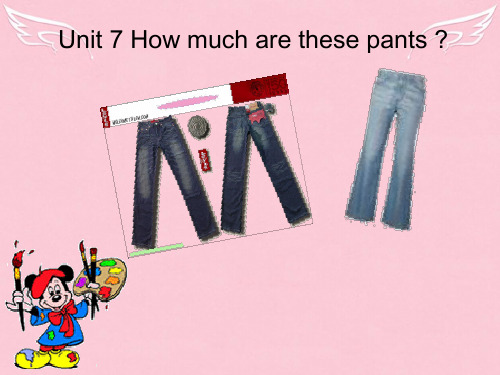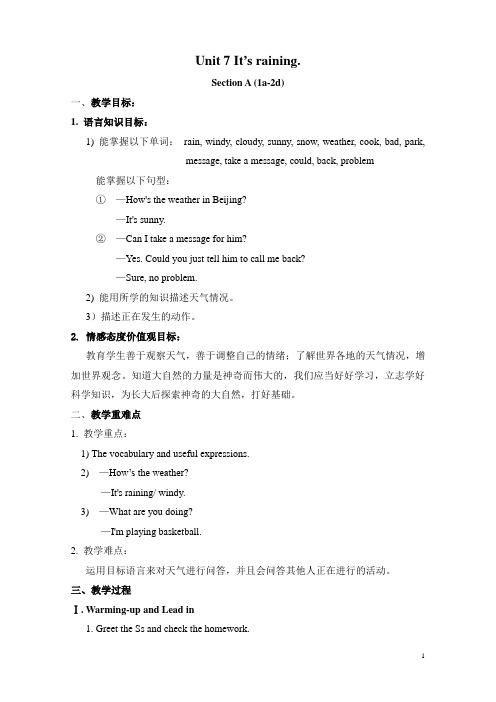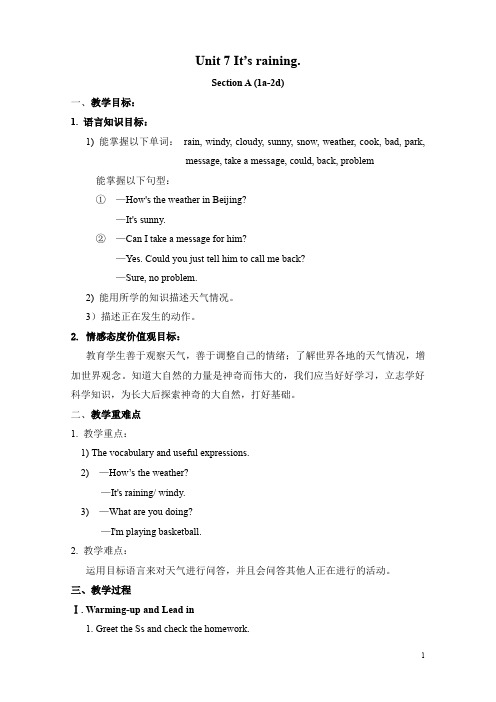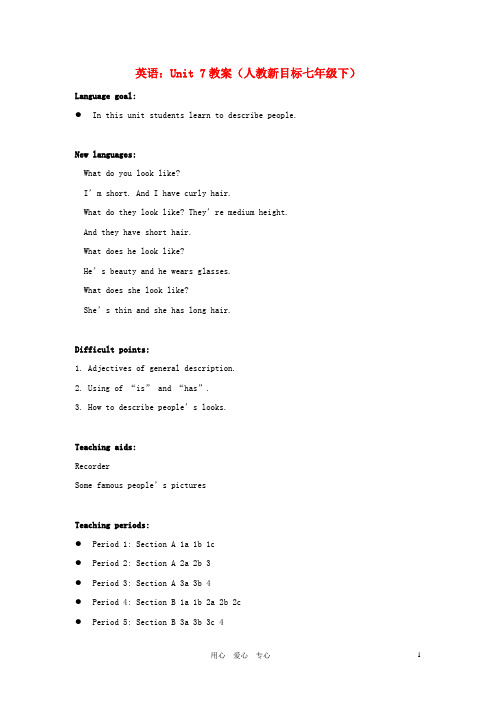初一英语下学期unit7-period3新目标
- 格式:ppt
- 大小:719.00 KB
- 文档页数:23


Unit 7 It’s raining.Section A (1a-2d)一、教学目标:1. 语言知识目标:1) 能掌握以下单词:rain, windy, cloudy, sunny, snow, weather, cook, bad, park,message, take a message, could, back, problem 能掌握以下句型:①—How's the weather in Beijing?—It's sunny.②—Can I take a message for him?—Yes. Could you just tell him to call me back?—Sure, no problem.2) 能用所学的知识描述天气情况。
3)描述正在发生的动作。
2. 情感态度价值观目标:教育学生善于观察天气,善于调整自己的情绪;了解世界各地的天气情况,增加世界观念。
知道大自然的力量是神奇而伟大的,我们应当好好学习,立志学好科学知识,为长大后探索神奇的大自然,打好基础。
二、教学重难点1. 教学重点:1) The vocabulary and useful expressions.2) —How’s the weather?—It's raining/ windy.3) —What are you doing?—I'm playing basketball.2. 教学难点:运用目标语言来对天气进行问答,并且会问答其他人正在进行的活动。
三、教学过程Ⅰ. Warming-up and Lead in1. Greet the Ss and check the homework.2. Watch a video program about the weather.Ⅱ. Presentation1. (Show some pictures of the weather)Let Ss look at the pictures and ask them how the weather is.Ss learn the new words and expressions with the help of the pictures.2. Look at the pictures in 1a. Then read the new words on the right. Ask the Ss tomatch the words with pictures.3. Check the answers.Ⅲ. Game (How's the weather?)1. (Showing some pictures on the big screen.) Ask Ss "How's the weather?"2. Ss guess and answer the question.Ⅳ. Listening1. Now let's look at the city names in the box in 1b. Please read after me.Ss read the cities after the teacher.2. Now, We’ll hear four conversations. Listen carefully, point out each city in thepicture as it comes upon the tape. Play the recording a second time. Ask Ss to write the name of the city in the picture of its weather.3. Check the answers.Ⅴ. Pair work1.Tell the Ss: If you are in one of the places in the picture above. Talk about theweather with your friends in another city on the phone.2. Make a model with a student like this:T: Hi! How's the weather in Beijing?S1: It's sunny.3. Ss work in pairs. Ask and answer about the weather in the cities.Ⅵ. Listening1. Work on 2a.Let's see what Joe's families are doing. Point to the 4 pictures.2. Ask Ss tell each person is doing in each picture. More attentions should be paidto the correct use of the Present Progressive Tense.3. Play the recording for the Ss to listen and number the pictures [1-4].4. Play the tape for Ss to check the answers.5. With the whole picture, get some Ss to tell the story of it.6. BrainstormingPlay the tape for another time. Then do a memory test.Ask Ss: What's Uncle Joe/Jeff/Mary/Aunt Sarah doing?What're Scott and Lucy doing?Is Jeff watching TV? etc.7. Let Ss match the names with the activities in 2b.Play the recording for the Ss to check the answers.Ⅶ. Pair work1. Look at the pictures and talk about the people in 2a with a partner.2. Ask a student the questions as a model:T: What's Uncle Joe doing?S1: He's playing basketball.3. Ss work in pairs. Ask and answer about the pictures.Ⅷ. Role-play1. Ask Ss to read the conversation and answer the questions:①What's Steve doing?②What's Rick's brother doing?Ss read the conversations and answer the questions. Then check the answers together.2. Let Ss role-play the conversation in pairs.IX. Language points.X. ExercisesHomework:一、总结有关天气的词汇。

新目标初一英语unit 7教案(通用4篇)新目标初一英语unit 7 篇1一.学情分析:本课是一个实用性较强的课,又与学生的生活经验和认知水平紧密相连,学生对本课时的学习将会体现出浓厚的兴趣。
另外本课时的新单词虽然很实用但却较多,学生在学习及使用单词的过程中将会产生一些障碍。
在教学过程中,应注意1,单词的读音及is 和 has的区别;2,tall, short 和 medium height; thin, heavy和medium build 的教学应注意其相对性。
最后,任务的设置应有明确的目的并具有可操作性,这样才有利于提高实际语言的运用能力。
二.教学目标:1.知识和能力目标:本课时的语言目标为描述人的外貌;学会谈论身高、体重、发型;围绕语言目标,学生应掌握“What does he/she look like? What do they/you look like? He is…He has…”等句型;学习并掌握“like, look like, curly, long,medium, build ”等重点词汇。
2.过程和方法目标:学生通过看、听、说、写掌握并使用描绘人的外貌的句型和词汇。
学生通过完成教材和教师设置的各项任务,使用这一课时的目标语言获取并分享信息,自由谈论他人的外貌特征。
3.情感态度目标:学生讨论和完成任务的过程是学生合作与交流的过程。
另外,在谈论他人的外貌是应注意使用委婉语,礼貌待人。
不要以貌取人(We mustn’t judge people by appearance)四,教学重难点:描绘人的外貌句型和词汇;句型中is和have/has的区别。
四:教学手段;多媒体图片五:教学方法:(Teaching Methods)呈现,归纳,讨论等(Scene teaching method Oral practice method Pairwork)六:教学过程 (Teaching Procedures)Step I: Lead-in (1 minute)Show 2 pictures to lead in today’s topic.Step II: Presentation (20 minutes)1. Show pictures to present one type of describing people’s looks (long hair).2. Present the new word (long hair) and the target language through the pictures: What does he look like? She has long hair.3. Get Ss to drill the sentences by asking and answering the question: What does she/he look like?4. Use almost the same steps as above to present other types of describing people’s looks and make Ss drill the target language.Step III. Consolidation (8 minutes).1. Ask several Ss to read these words, target language and describe the people’s looks according to the pictures (3minutes)2. Listening practice with a game—Bingo (5 minutes)(1). Get the class to do 1a quickly, then check the answer with whole class.(2), Make sure Ss know what to do, then play a game—Bingo by using these words and target language.Step IV. Practice (9minutes)1.Ask Ss to take out their photos and make dialogues like this:A: Is this your family photo?B: Yes, it isA: Who is your mother?B: She is medium height, has short curly hair. She is thin.A: Aha I find her, is it her?B: Yes, it is. You’re clever. What do your parents look like?A: My father…and my mum…Then ask several pairs to act their dialogues out.2. Invite one student to draw a picture of a person, and write down the description of the personStep V Summary (1minute)New words and target language. The differences of “is and have/has”Step VI. Homework (1minute)1. Copy the new words learned in this lesson 3 times.2. Write down the dialogue they’ve made in the class新目标初一英语unit 7教案篇2Unit 6 What does he look like? 教案授课人: 王忠清课型: 本单元第一课时班级: 初2007级7班时间: 05/04/05第2节一.学情分析:本课是一个实用性较强的课,又与学生的生活经验和认知水平紧密相连,学生对本课时的学习将会体现出浓厚的兴趣。

Unit 7 It’s raining.Section A (1a-2d)一、教学目标:1. 语言知识目标:1) 能掌握以下单词:rain, windy, cloudy, sunny, snow, weather, cook, bad, park,message, take a message, could, back, problem 能掌握以下句型:①—How's the weather in Beijing?—It's sunny.②—Can I take a message for him?—Yes. Could you just tell him to call me back?—Sure, no problem.2) 能用所学的知识描述天气情况。
3)描述正在发生的动作。
2. 情感态度价值观目标:教育学生善于观察天气,善于调整自己的情绪;了解世界各地的天气情况,增加世界观念。
知道大自然的力量是神奇而伟大的,我们应当好好学习,立志学好科学知识,为长大后探索神奇的大自然,打好基础。
二、教学重难点1. 教学重点:1) The vocabulary and useful expressions.2) —How’s the weather?—It's raining/ windy.3) —What are you doing?—I'm playing basketball.2. 教学难点:运用目标语言来对天气进行问答,并且会问答其他人正在进行的活动。
三、教学过程Ⅰ. Warming-up and Lead in1. Greet the Ss and check the homework.2. Watch a video program about the weather.Ⅱ. Presentation1. (Show some pictures of the weather)Let Ss look at the pictures and ask them how the weather is.Ss learn the new words and expressions with the help of the pictures.2. Look at the pictures in 1a. Then read the new words on the right. Ask the Ss tomatch the words with pictures.3. Check the answers.Ⅲ. Game (How's the weather?)1. (Showing some pictures on the big screen.) Ask Ss "How's the weather?"2. Ss guess and answer the question.Ⅳ. Listening1. Now let's look at the city names in the box in 1b. Please read after me.Ss read the cities after the teacher.2. Now, We’ll hear four conversations. Listen carefully, point out each city in thepicture as it comes upon the tape. Play the recording a second time. Ask Ss to write the name of the city in the picture of its weather.3. Check the answers.Ⅴ. Pair work1.Tell the Ss: If you are in one of the places in the picture above. Talk about theweather with your friends in another city on the phone.2. Make a model with a student like this:T: Hi! How's the weather in Beijing?S1: It's sunny.3. Ss work in pairs. Ask and answer about the weather in the cities.Ⅵ. Listening1. Work on 2a.Let's see what Joe's families are doing. Point to the 4 pictures.2. Ask Ss tell each person is doing in each picture. More attentions should be paidto the correct use of the Present Progressive Tense.3. Play the recording for the Ss to listen and number the pictures [1-4].4. Play the tape for Ss to check the answers.5. With the whole picture, get some Ss to tell the story of it.6. BrainstormingPlay the tape for another time. Then do a memory test.Ask Ss: What's Uncle Joe/Jeff/Mary/Aunt Sarah doing?What're Scott and Lucy doing?Is Jeff watching TV? etc.7. Let Ss match the names with the activities in 2b.Play the recording for the Ss to check the answers.Ⅶ. Pair work1. Look at the pictures and talk about the people in 2a with a partner.2. Ask a student the questions as a model:T: What's Uncle Joe doing?S1: He's playing basketball.3. Ss work in pairs. Ask and answer about the pictures.Ⅷ. Role-play1. Ask Ss to read the conversation and answer the questions:①What's Steve doing?②What's Rick's brother doing?Ss read the conversations and answer the questions. Then check the answers together.2. Let Ss role-play the conversation in pairs.IX. Language points.X. ExercisesHomework:一、总结有关天气的词汇。

英语:Unit 7教案(人教新目标七年级下)Language goal:●In this unit students learn to describe people.New languages:What do you look like?I’m short. And I have curly hair.What do they look like? They’re medium height.And they have short hair.What does he look like?He’s beauty and he wears glasses.What does she look like?She’s thin and she has long hair.Difficult points:1. Adjectives of general description.2. Using of “is” and “has”.3. How to describe people’s looks.Teaching aids:RecorderSome fam ous people’s picturesTeaching periods:●Period 1: Section A 1a 1b 1c●Period 2: Section A 2a 2b 3●Period 3: Section A 3a 3b 4●Period 4: Section B 1a 1b 2a 2b 2c●Period 5: Section B 3a 3b 3c 4Period 6: Self-checkPeriod 1Teaching aims:1. Learn the new vocabulary words:2. Target language:What does your friend look like?She is of medium build, and she has long hair.3. Be able to use “is” and “has”.4. Learn to describe the people’s looks.Teaching procedures:Step 1.Warm-upTalk about you r classmates’ builds and heights:“Is Lucy tall?” “Yes/No …”“Is Jim fat?” “Yes/No …”“Does he have long hair?” “Yes/No …”Step 2. Key vocabulary (1a)Focus attention on the words. Ask students to read the list of words. Then say each word and ask students to repeat it.On the board, make a simple drawing to illustrate each of the words. As you complete each drawing, point to it and ask students what it shows. If they don’t know, say the word and ask students to repeat it. For example, drawa stick figure with very long legs and a long body. When you point to the figure,students say tall.Call attention to the picture. Point to the letters next to the people in the picture.Say, Use the letters to match the people in the picture with one of the numbered words. Write each letter next to a numbered word. You can use some lettersmore than once. Point out the sample answer.Check the answers.Step 3. Listening (1b)Call attention to the speech bubbles in the picture. Read the dialogue, saying blank when you come to a blank line.Say, You will hear a conversation between Amy and her friend. Fill in the blank likes in their conversation. Then look at the picture and find the boy Amy is talking about.Play the recording the first time. Students only listen.Play the recording a second time. This time, students fill in the blanks in the speech bubbles.Say, who are they talking about?Check the answers.Step 4. Pair work (1c)Call attention to the various people in the picture. Say, One of these people is your friend.Point out the sample conversation. Ask two students to read it to the class.Then ask the class to point to the girl in the picture who has long hair and is medium build.Say a dialogue with a student. Have the student ask you the question. You then answer it using a description of one of the people in the picture. Ask the student to point out the person you described.Say, Now work with a partner. Ask the answer the questions.Then have students work in pairs. As they talk, move around the room monitoring their work.Homework1. Ask the students to make conversations according to the model in 1c.2. Ask the students to learn the new words and expressions in this period.Period 2Teaching aims:1. Learn the vocabulary words and useful expressions.2. Target languages:What do you look like? I’m short. I’m thin.What do they look like? They’re of medium height.What does he look like? He is of medium build.What does she look like? She is tall. She has curly hair.3. Enable the students to describe people.4. Help the student learn how to describe people.Teaching procedures:Step 1. RevisionCheck the homework. Ask some students to work in pairs and make conversations.Step 2. Listening (2a)Point to the list of nine phrases and ask a student to read them to the class. Say, Now you will hear three conversations. The people are talking about friends. They are using these words to describe their friends. Some of these words go with “has” and some go with “is”.Point to the c ircle around the word “circle”. Say, Circle the correct word, either is or has, when you hear it in the conversation.Play the recording the first time. Students only listen. Point out that there are three different conversations about three different people.Play the recording a second time. This time say, Circle “has” or “is”. You may wish to play the recording a third time to allow slower students to complete their work and to let other students check their answers.Step 3. Listening (2b)Point at the chart with space for two words used with is and two words used with has after each name.Call attention to the sample answers. As you point to the word is, say a sentence using the sample answer tall: He’s tall. Point to the word has and say a sen tence using the sample answer curly hair. He has curly hair.Play the recording. Ask students to listen to the descriptions and write the words in the correct column after each person’s name.Step 4.Pair work (3)Call attention to the dialogue in the box and the picture. Explain that students have to complete the dialogue with words to describe Nancy’s looks.Have students do the activity individually. As they work, move around the classroom offering help as necessary.Step 5.Grammar FocusReview the grammar box. Ask students to read the questions and answers.Point out that do goes with the you and they questions and does goes with the he and she questions.Point to I’m, they’re, he’s and she’s with descriptions of height and build.You may wish to say, We use the verb to be-am, is, are-to talk about how tall someone is or if they’re heavy or thin.HomeworkAsk the students to make conversations according to activity 3.Period 3Teaching aims:1. Teach vocabulary words.2. Target languages:What does Paul look like?He’s tall and he has brown hair.This person is of medium height. She has short hair.3. Enable the students to talk about what people look like.4. Help the students learn how to talk about what people look like.Teaching procedures:Step 1. Warming upCheck the homework by asking some students to read the conversation in activity3.Step 2. Reading and Matching (3a)Draw attention to the pictures and the pictures with the correct descriptions.Point out the example. Have a student read the first description.Students do the activity individually.Check the answers.Step 3. Pair work (3b)Call attention to the picture and the names in the box. Say, Student A has to write the names in the box next to the people in the picture. Then studentB has to ask questions to find the people. Remind students that they shouldnot look at each other’s textbooks when they do this activity.Have two students read out the example dialogue in the speech bubbles. Then ask students to do the activity in pairs. As students talk, walk around the classroom listening and offering assistance as necessary.After several minutes, stop the activity and have several pairs present their dialogues to the class.Step 4. Game (4)Give a sample description of someone in the class and ask the class to guess who you are describing. Use only words and sentence patterns from this unit.For example, She’s short and thin. She has curly hair.Ask some students to describe a person while their classmates guess who it is.HomeworkWrite s short article to describe your four classmates.Period 4Teaching aims:1. Teach vocabulary words.2. Target languages:My favorite musician is John Jackson.He is tall and thin.He has short curly brown hair.3. Enable the students to talk about their favorite star.4. Help the students learn how to talk about their favorite star.Teaching procedures:Step 1. Warming upShow some pictures and ask the students to describe the people in these pictures.Step 2. Match work (1a)Focus attention on the four pictures. Ask students to tell what they see in each picture. Confirm each correct answer and supply any words students don’t know.Point at the numbered list of words. Say each word and ask students to repeat these words.Then ask students to match each word with one of the pictures. Say, Write the letter next to the picture in front of the words. Point out the sample answer. Check the answers.Step 3. Sentences (1b)Point at the incomplete sentences and read the completed sample sentence to the class.Ask students to work alone or in pairs. Have students write the name of a famous person in each blank.Ask some students to read the sentences they completed. Have other students say whether the sentences are right or wrong.Step 4. Listening (2a)Point out the picture of Johnny Dean and Tina.Brown and Maria and Danny. Say, You will hear Maria and Danny talking about Tina Brown and Johnny Dean. Your job is to write the job each person does.Point to the heading “Job” on the chart.Play the recording the first time. Students only listen.Play the recording a second time. This time ask students to fill in the blanks in the chart.Correct the answers.Step 4. Listening (2b)Say, You will hear Maria and Danny talking about Tina Brown and Johnny Dean again. This time your job is to write what each person looks like. Point to the heading “look like”.Play the recording. Ask students to fill in the blanks next to the words “Looks like” on the chart.Correct the answers.Step 5. Groupwork (2c)Name a famous actor, musician or athlete and describe that person. For example,My favorite actor is Leonardo DiCaprio. He’s medium height and he has brown hair.Ask students to work in small groups. Have students describe a famous person to the group. Ask others in the group to add information to each description, if possible.HomeworkAsk the students to find some photos or draw some pictures of their own, their family or friends. Then describe the person in these pictures.Period 5Teaching aims:1. Teach vocabulary words.2. Target languages:He’s of medium height.He has curly black hair.He is thin.He wears glasses.3. Enable the students to read and write about what people look like.4. Help the students learn how to read and write about what people look like.Teaching procedures:Step 1. Reading (3a)Call attention to the two pictures of Johnny Dean.Ask students if they are pictures of one person or two different people. Lead students to understand that they are the same person in different time.Ask students to read the magazine article individually. Move around the room answering any questions students may have.Read the magazine article to the class. Answer any further questions about the words in the story students may have.Point out the blanks in the chart. Say, Under “Before” write words that describe Johnny before he changed. Under “ Now” write words that describe Johnny after he changed. Point out the sample answer.As student work, move around the room monitoring progress.Step 2. Writing (3b)Call attention to the passage and the picture below. Explain that the passage describes how Gloria Green’s look has changed. Point out the sample answer, and ask a student to provide the second answer (short hair).Point out the numbered blanks in the paragraph. Say, write words describing Gloria’s looks in each blank.Ask students to finish the activity on their own.Correct the answers.Step 3.Writing (3c)Ask each student to choose a family member and write a short description of the person.Ask what new words students want to use in their descriptions. When you understand what a student wants to say, write the word on the board, explain it to the class and have the class repeat it. Limit this to two or three new words.As students write, move around the room answering questions and offering language support.Read some of the completed descriptions to the class.Step 4.Game (4)Read the instructions. Check to see that students understand how the game is played.Ask each student to draw a picture without letting anyone else see it.Have students get into groups of four. Tell the students in each group to give themselves numbers from 1 to 4.Ask the other three students in each group to listen to the description and draw the person. You may wish to have them listen to the description several times.Ask each group to swap its pictures with another group. That group votes to decide which of the three copies looks most like the original picture. The student who drew that copy is the winner.HomeworkAsk the students to write another composition about one of their family members.Period 6Teaching aims:1. Teach vocabulary words.2. Enable the students to describe people.3. Help the students learn how to write articles to describe people.Teaching procedures:Step 1.Key word check (1)Ask students to check all the words they know. You may wish to have students circle any words that they don’t know.Ask students to find out the mea nings of any words they don’t know. They can do this by reviewing the unit, asking you, asking their classmates, or usinga learner’s dictionary or bilingual dictionary.Step 2.Vocab-Builder (2)After students have recorded their new words, ask them to share their lists with other students. This can be done with the whole class or informally, in pairs or small groups.Step 3. Talking about the picture (3)Draw attention to the picture and the questions in the box. Ask one student to describe what “Old Henry” looks like (He’s short. He is medium build.)Have students do the activity individually.Check the answers.Step 4. Just for Fun!Ask students to read the cartoon to themselves.Ask, What is funny about this cartoon? Lead students to understand that the idea of what “tall” and good-looking” mean may be different on different planets.Homework1. Ask the students to summarize what they have learned in this unit.2. Ask the students to prepare for the next unit.。

Unit 7 It’s raining第1课时关店中学:胡尹一、学习目标1.掌握单词: rain, windy, cloudy, sunny, snow, weather, cook, study, bad, terrible, pretty句型: How’s the weather in Shanghai? It’s cloudy. What are you doing? I’m watching TV.2.学会谈论天气及描述你正在做的事;3.表达对天气的喜好并说明原因,学会使用现在进行时描述人们正在做的事。
二、学习重点1.掌握单词: rainy、windy、cloudy 、sunny 、snowy、weather2.重点句型:- How’s the weather in Shanghai? - It’s cloudy.- What are you doing? - I’m watching TV.三、学习过程(一)课前准备预习导学及自测1.预习p31生词,做到会读知意。
2.认知城市名称。
3.探究发现:表天气的名词如何变成形容词?完成下列单词多雨的_____ 多雪的_______ 有风的_______ 阴天的________晴朗的____ cook(现在分词) ________ study(单数第三人称)_________糟糕的_________(二)课堂活动Step1 情境导入1. Do 1a. Look at the pictures and match the words with the pictures in small groups.2. 看图听1b的录音,把地名填入图中的方框里;3. 自我练习1c,根据上边的每张图进行问答:Step2 自主探究1. Summary:(1) 询问天气情况:_____________________ / ____________________?(2) 询问某人正在干什么:_____________________________________?2. Do 2a . Listen and number (1-4) the pictures as you hear them.Listen again and match the names with the activities.Step 3 合作交流1. Do 3a. Match the words with the faces in the box.2. Do3b. Pairwork.3. Talk about the weather with your friends in groups.Step 4 课堂点拨1. How’s the weather? =What’s the weather like ?都是用来询问天气状况的句型。
港南一中七年级英语下册导学案设计主备人:陶雄辉课题:Unit7 It’s raining!Section A 1a-2c (The first period)课型:听说综合课学习目标1、我能根据音标拼读新单词rain, windy, cloudy, sunny, snow, weather, cook (重点)2、我能熟练运用以下句型来谈论天气以及人们正在进行的活动:(难点)How’s the weather in Beijing? It’s sunny.What’s he doing? He’s playing basketball.3、情感态度:通过本节课的学习,我会更加关心天气,热爱大自然。
知识链接1、现在进行时:表示正在发生的行为或动作。
其结构为be doing。
如:It is raining. I am doing my homework. My parents are watching TV.2、构词法:表示天气的名词+y,可变为形容词。
rain→rainysun→sunny wind →windy cloud→cloudysnow→sn owy3、同义句:How’s the weather? = What’s the weather like? 天气如何?学法指导:首先要明确本节课的话题——谈论天气以及不同天气状况下开展的活动。
围绕着这一话题应该用到哪些词、哪些句?通过阅读1a到2c的内容就能弄清楚。
Learning Process (学习过程)Step I温故知新,承上启下(2分钟)用所给单词的正确形式填空:1. —What are you doing? —I am ____________ (watch) TV.2. What _________ (be) she doing? She is ______________ (wash) her clothes. StepⅡ目标导航,自主学习(10分钟)1、我能根据音标拼读新单词rain, windy, cloudy, sunny, snow, weather, cook,把不会拼读的用红笔做标记。